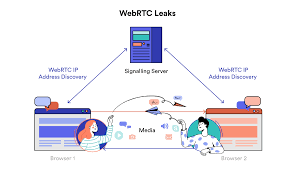In the vast digital world, where every click can lead to a new adventure or a hidden peril, browser security stands as a vigilant guardian of our data. It encompasses the strategies and technologies that shield internet users from the myriad threats lurking in the shadows of online interactions. This article aims to unravel the intricate tapestry of browser security, shedding light on its significance and the various components that work together to create a safe browsing environment.

As we navigate the internet for countless purposes—whether it’s indulging in retail therapy, managing our finances, connecting with friends and family, or seeking knowledge—the imperative for strong browser security has never been more pronounced. This exploration will take us deep into the essential elements of browser security, offering a thorough insight into this vital aspect of protecting our privacy in an increasingly interconnected world.
At its essence, browser security is a complex phenomenon woven together by numerous threads. Its primary goal is to safeguard users and their sensitive information from potential dangers that may emerge during their online journeys. This protective framework includes a range of tactics designed to thwart unauthorised access, prevent data breaches, and counter various cyber threats that can disrupt our digital lives.
However, browser security extends beyond the sophisticated tools and technologies employed to shield users. It also hinges significantly on user behaviour and awareness. To indeed fortify one’s browsing experience, individuals must comprehend the risks that exist and learn how to navigate them effectively. Being informed about potential threats and knowing how to avoid them is a crucial piece of the puzzle in fostering a secure online atmosphere.
In an age where our reliance on the internet continues to grow, understanding and prioritising browser security has become paramount. It is not merely an afterthought but rather an essential element of our digital existence. By embracing technological safeguards and cultivating a mindset of vigilance, we can ensure that our online experiences remain not only enjoyable but also safe.
The Significance of Browser Security: A Tale of Digital Protection
Once upon a time, in the vast realm of the Internet, where information flowed like rivers and connections were forged with a mere click, there existed a hidden danger lurking in the shadows. This danger took many forms—malicious software that crept into devices unnoticed, deceitful schemes designed to trick unsuspecting users into revealing their personal information, and sinister plots aimed at stealing identities. The inhabitants of this digital world soon realised that safeguarding themselves against these threats was not just important; it was essential.

In this vast expanse, where people shared everything from cherished memories to sensitive financial data, the need for robust browser security became increasingly evident. Imagine a castle filled with treasures—each piece of personal information, be it bank details or social security numbers, was a precious gem that could easily fall into the wrong hands if left unguarded. Those who understood the importance of browser security were akin to wise rulers, ensuring that their domains were fortified against potential invaders. They knew that by protecting their digital presence, they could maintain their privacy and prevent the devastating consequences of cybercrime, such as financial ruin or tarnished reputations.
As our story unfolds, we discover that browser security comprises several vital components, each playing its unique role in this grand tale of defence. At the heart of it all lies secure design—the very blueprint of a browser that determines its strength against intruders. Just as a fortress is constructed with thick walls and watchtowers, a well-designed browser incorporates advanced features to fend off attacks.
But even the most substantial castle needs vigilant guards. This is where user awareness comes into play. Knowledge is power, and those who understand the risks of the digital landscape can better navigate its perils. They learn to identify suspicious activities and adopt strategies to protect themselves from harm. Alongside this wisdom, security tools emerge as trusted allies—software and hardware designed to act as shields against various threats.
In the journey toward browser security, some additional elements come into focus. Regular updates serve as the ongoing maintenance of our digital fortress, ensuring that it remains equipped with the latest defences against emerging dangers. Secure browsing practices are akin to wise travellers who choose safe paths and avoid treacherous terrains—those who steer clear of dubious websites are less likely to encounter trouble. And then there’s encryption, a magical spell that transforms data into an unreadable code, accessible only to those with the secret key—a powerful safeguard against prying eyes.

As our tale continues, it becomes clear that in the ever-evolving landscape of cyberspace, browser security is not merely a precaution; it is a vital lifeline for individuals seeking to protect their most valuable assets. Just as knights defended kingdoms from foes, so too must every internet user take up the mantle of responsibility in securing their online experiences. Within this digital kingdom, knowledge, vigilance, and the right tools can pave the way for safer journeys across the internet’s vast expanse.
Understanding the Landscape of Browser Security Threats
In today’s digital age, users must familiarise themselves with the myriad of browser security threats that lurk in the online realm. These threats range from malevolent software and deceptive schemes to more sophisticated attacks like cross-site scripting and clickjacking. Gaining knowledge about these dangers is the crucial first step in learning how to defend against them.
The Menace of Malware
At the forefront of these threats lies malware, a term that refers to any software specifically designed to harm or infiltrate a computer system without authorisation. Picture this: a cybercriminal lurking in the shadows, deploying various forms of harmful software—viruses, worms, trojans, ransomware, and spyware—all engineered to wreak havoc. These insidious programs can corrupt files, steal sensitive information, or even grant unauthorised access to the user’s computer.

Malware can enter a system through multiple channels. It might sneak in when a user downloads a seemingly harmless file, visits a compromised website, or opens an attachment from an untrustworthy email. Once malware gains entry, it can unleash chaos—slowing down the device, pilfering confidential data, or even seizing complete control over the system.
The Deceptive Art of Phishing
Then there’s phishing, a cunning tactic employed by cybercriminals to ensnare unsuspecting users into divulging their private information. Imagine receiving an email that looks as though it comes from your bank or a well-known social media platform. It seems legitimate; perhaps it even carries a familiar logo. However, beneath this facade lies a trap designed to extract sensitive details like passwords or credit card numbers for malicious use.
Phishing manifests in various guises. There’s the classic email phishing, where fraudulent messages masquerade as communications from reputable sources. Then we have spear phishing—this is where attackers focus their efforts on particular individuals or organisations, crafting personalised messages that make their deceit all the more convincing. Finally, there’s whaling, which targets high-profile individuals, such as executives or key decision-makers, making it a hazardous form of phishing.
Cross-Site Scripting and Clickjacking
As we delve deeper into this digital landscape, we encounter other significant threats like cross-site scripting (XSS) and clickjacking. Cross-site scripting involves an attacker injecting malicious scripts into websites that unsuspecting users visit. This can lead to unauthorised actions being performed on behalf of the user without their consent.

On the other hand, clickjacking is a more insidious trick. Here, users are misled into clicking on elements they believe are harmless but are actually concealed layers that trigger unintended actions. Imagine thinking you’re pressing a button to play a video when, instead, you’re approving a hidden transaction—this is the deceptive nature of clickjacking.
Empowerment Through Knowledge
In conclusion, navigating the world of browser security threats requires vigilance and awareness. By understanding malware’s destructive potential, recognising phishing scams, and being alert to attacks like cross-site scripting and clickjacking, users can take informed steps to safeguard their online presence. The first line of defence is always knowledge—arming oneself with information is vital in outsmarting those who would seek to exploit our digital lives.
The Guardians of the Web: Anti-Phishing Filters and Secure Browsing Practices
In the vast expanse of the digital universe, where information flows freely,y and interactions unfold in an instant, the spectre of deceit lurks just beneath the surface. Among the diligent protectors of our online journeys are the anti-phishing filters, a vital component of modern browser security. These filters serve as vigilant sentinels, alerting users when they venture too close to treacherous shores—those fraudulent websites designed to ensnare the unwary. They operate by meticulously comparing the URLs we traverse against a comprehensive database of known phishing sites. Should they detect a match, a warning emerges, urging the user to turn back before falling into the trap.

Yet, like all guardians, anti-phishing filters are not infallible. The ever-evolving landscape of cybercrime means that new phishing sites spring up almost daily, and there is often a delay before these malicious addresses are catalogued in the filter’s database. This reality underscores the importance of user vigilance; sensitive information should be shared only with those sites that bear the mark of legitimacy, a secure connection indicated by the reassuring ‘https’ in their web address.
But the protection offered by anti-phishing filters is just one layer in the armor against online threats. Users wield additional power in their quest for secure browsing by adopting prudent practices that can bolster their defences. Steering clear of suspicious websites stands out as one of the most effective strategies. These questionable domains may harbour malware or be specifically designed to execute phishing schemes. Users must be particularly cautious of any site that solicits personal or financial data without proper security measures in place.
In this digital age, downloading files from untrustworthy sources is another perilous act that could lead to unwanted malware infiltrations. The allure of free downloads often masks hidden dangers, making it wise to think twice before clicking on links that promise something for nothing.
Moreover, staying updated is akin to fortifying one’s castle walls against invaders. Regularly refreshing browsers and other software ensures that users benefit from the latest security enhancements designed to ward off emerging threats.
As our story unfolds in this intricate web of connectivity, avoiding suspicious websites emerges as a cornerstone of secure browsing practices. It is a tale of caution and awareness, where every click carries the potential for discovery or danger. Users are encouraged to trust their instincts; if a website seems dubious or too appealing to be accurate, it’s often best to steer clear and seek safer pastures.
In this ongoing narrative of online exploration, individuals armed with knowledge and vigilance can navigate the digital realm more securely, safeguarding their personal information and enjoying their journeys through cyberspace with greater peace of mind.
In the digital landscape we navigate daily, the safety of our online experiences hinges significantly on browser security, a fundamental pillar of data privacy. This intricate web of protection encompasses a multitude of factors, ranging from the inherent design and security mechanisms of the browser itself to the crucial role that user awareness and behaviour play in safeguarding personal information. By delving into the realm of potential cyber threats and learning practical strategies to counteract them, individuals can fortify their defences against the myriad dangers lurking in the shadows of the internet.

Although modern browsers are equipped with an array of security features designed to shield users from harm, these protections are not infallible. The onus ultimately lies with users to adopt a proactive stance, cultivate vigilance, and adhere to best practices for secure browsing. This means steering clear of dubious websites that may harbour malicious intent, refraining from downloading files from sources that lack credibility, and ensuring that both the browser and related software are regularly updated to fend off emerging vulnerabilities.
By embracing these prudent habits, users can weave a tapestry of safety around their online activities, transforming their internet journeys into experiences marked by confidence and security. In this ever-evolving digital age, where threats can emerge unexpectedly, the commitment to vigilant browsing will pave the way for a more secure and enjoyable online existence.
Maxthon
In the fast-paced world of online interactions, where the digital landscape is ever-changing, ensuring one’s safety while navigating the internet has taken on new significance. The importance of selecting a web browser that emphasises security and privacy cannot be overstated; it is more crucial now than ever. Among the myriad browsers available, Maxthon Browser stands out as a remarkable option, addressing these essential needs without imposing any costs on its users. This advanced browser comes loaded with an impressive array of built-in features, such as an Adblocker and various anti-tracking tools, all vital components for bolstering your online privacy.

Maxthon has carved out a niche for itself by dedicating its efforts to creating a browsing experience that prioritises user safety and confidentiality. With a strong emphasis on shielding personal information and online activities from a host of potential dangers, Maxthon implements a variety of robust strategies to protect user data. Utilising cutting-edge encryption techniques, this browser guarantees that sensitive information remains secure and private throughout your internet journeys.
When it comes to enhancing privacy during online activities, Maxthon truly shines. Every aspect of the browser has been thoughtfully crafted with an array of features specifically designed to elevate your privacy levels. From ad blockers to anti-tracking capabilities and incognito mode, these tools work harmoniously to eliminate disruptive advertisements and prevent tracking scripts from intruding on your online experience. As a result, users can roam the internet with a heightened sense of security. Furthermore, the incognito mode enriches this sense of safety, enabling users to explore the web without leaving behind any digital footprints or traces on their devices.
Maxthon’s steadfast dedication to user privacy and protection is evident in its consistent updates and ongoing improvements. This commitment to enhancing user safety underscores its mission to create a secure browsing environment where users can feel at ease.

